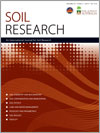SR13100Digital mapping of a soil drainage index for irrigated enterprise suitability in Tasmania, Australia
Global attention to food and water security is increasingly being informed by Digital Soil Mapping (DSM), a science that uses complex modelling and statistical techniques. DSM was used to map the suitability of various crops in Tasmania; however, an important consideration was soil drainage, which generally requires expensive field measurements to inform DSM, but was beyond the available budget. This paper demonstrates expert field estimates can be applied instead to DSM to produce cheaper, but effective soil drainage suitability mapping.




